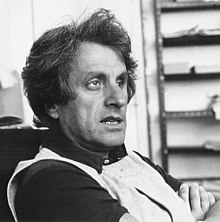Komboï
| Komboï | |
|---|---|
| by Iannis Xenakis | |

Iannis Xenakis c. 1970
|
|
| Period | Contemporary music |
| Genre | |
| Composed | 1981 |
| Dedication | Elisabeth Chojnacka and Silvio Gualda |
| Performed | 21 December 1981: Metz |
| Duration | 17 minutes |
| Scoring | Percussion and harpsichord |
Komboï (Greek: Κόμβοι, Knots) is a 1981 composition for amplified harpsichord and percussion by Greek composer Iannis Xenakis. It is one of the two compositions for harpsichord and percussion written by Xenakis, the other one being Oophaa.
Xenakis composed Komboï after a long collaboration with both harpsichordist Elisabeth Chojnacka and percussionist Sylvio Gualda, which at that time formed a duo and commissioned works for both instruments to other composers. As Xenakis worked previously with both musicians (he also composed Khoai for Chojnacka in 1976 and Psappha for Gualda in 1975), the composer was much more focused in exploring the timbral capabilities of both instruments by creating an homogeneous sound texture. It is indeed dedicated to Gualda and Chojnacka, the latter being the dedicatee of all five compositions for harpsichord by Xenakis. It was eventually premiered by the duo on December 22, 1981, at the Rencontres Internationales de Musique Contemporaine in Metz.
The composition is in only one movement and takes approximately 17 minutes to perform. It is scored for one harpsichord, one vibraphone, two wood blocks, two bongos, three congas, four tom-toms, one bass drum, and seven terracotta flower pots. As put by Xenakis, Komboï explores "non-octave scales", its rhythm examines "anthypheresis" (displacement of stress), and its timbres exploit "the antitheses or homeophanies of the amplified harpsichord and percussion." In this sense, Komboï means knots, as "knots of rhythms, timbres, structures, and personality," interweaving each one with others. To make instruments blend more effectively, Xenakis used amplification in all of his works for harpsichord.
...
Wikipedia
